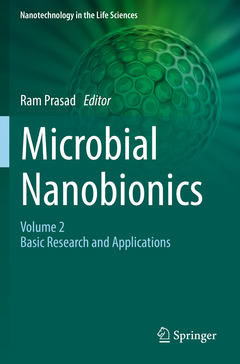Description
Microbial Nanobionics, 1st ed. 2019
Volume 2, Basic Research and Applications
Nanotechnology in the Life Sciences Series
Coordinator: Prasad Ram
Language: English
Subjects for Microbial Nanobionics:
Publication date: 08-2020
290 p. · 15.5x23.5 cm · Paperback
Publication date: 07-2019
290 p. · 15.5x23.5 cm · Hardback
Description
/li>Contents
/li>Biography
/li>Comment
/li>
Contents
1. Green synthesis of nanoparticle from microbial origin: from approaches to application
1Department of Plant Pathology, SD Agricultural University, SK Nagar, Gujarat
Email id: jpurohit86@gmail.com ; anirudhbhu@gmail.com
2Department of Plant Pathology, Anand Agricultural University, Anand, Gujarat
Email id: pujapandey41124@gmail.com3Department of Microbiology, SD Agricultural University, SK Nagar, Gujarat
*Corresponding author Email: nirbhaysingh78@gmail.com
2. Microbial synthesis of nanoparticles and their applications
Hacettepe University, Nanotechnology and Nanomedicine Division, Ankara Turkey e-mail: saglam@hacettepe.edu.tr
3. Enzyme nanoparticles: Microbial source, applications and future perspectives
Lekshmi K. Edison, Ragitha V.M. and Pradeep N.S.*
Microbiology Division, Jawaharlal Nehru Tropical Botanic Garden and Research Institute, Palode, Trivandrum, Kerala- 695562, India
*Corresponding author E-mail: drnspradeep@gmail.com
4. Applications and future perspectives of nanomaterials towards Microbial nanobionics
Prof. Dr. techn. Murthy CHAVALI
chavalim@gmail.com
5. Bacterial nanobionics: Currents challenges before translational medicine
Farid Menaa1*, Bushra Uzair2 and Barkat Ali Khan3
1California Innovations Corp., San Diego, CA, USA
2Department of Environmental Sciences, International Islamic University, Islamabad, Pakistan. Email: bushra.uzair@iiu.edu.pk
3Department of Pharmaceutics, Gomal University, Dera Ismail Khan, Pakistan. Email: barki.gold@gmail.com
*Corresponding author Email: dr.fmenaa@gmail.com
6. Toxicity of nanomaterials in microbes, Human health and Environment
Majid Peyravi1*, Soodabeh Khalili2, Mohsen Jahanshahi3 and Seyedeh Fatemeh Zakeritabar4
1Nano-Environment Research Group, Nanobiotechnology Research Institute,
Babol Noshirvani University of Technology, Babol, P.O.BOX: 484, Iran
*Corresponding author Email: majidpeyravi@gmail.com ; majidpeyravi@nit.ac.ir
2Nanobiotechnology Research Institute, Babol Noshirvani University of Technology, Babol, P.O.BOX: 484, Iran. Email: soodabeh.khalili@yahoo.com
3Nanotechnology Research Institute, Babol Noshirvani University of Technology, Babol, P.O.BOX: 484, Iran
Email: mjahan@nit.ac.ir ; mmohse@yahoo.com
4Nanobiotechnology Research Institute, Babol Noshirvani University of Technology
Babol, P.O.BOX: 484, Iran. Email: f.zakeritabar@gmail.com
7. Toxicity of nanomaterials in microbes
Cristina Buzea* and Ivan PachecoIIPB Medicine Corporation, Owen Sound, N4k 6S5, Canada
*Corresponding author Email: cristinabuzea@mdcorporation.ca ; cristinabuzea@yahoo.com
8. Carbon Quantum Dots from green precursors with amplified photoluminescence: Synthesis, characterization and its application
Lan Ching Sim1*, Kah Hon Leong1, Jun Yan Tai1, Pichiah Saravanan2, Azrina Abd Aziz3
1Environmental Engineering Dept., Faculty of Engineering and Green Technology, UTAR Kampar
*Corresponding author Email: simcl@utar.edu.mycc: Saravanan Pichiah , Kah Hon Leong ,
Tai Junyan , Azrina Abd Aziz ^</p>
9. Nanomaterials, polymers and smart packing for food materials
M. Q. Marin-Bustamantea, J.J. Chanona-Péreza,*, N. Gϋemes-Verab, J.A. Mendoza-Pérezc, R.G. Cásarez-Santiagoa
Jorge Chanona Pérez
Laboratorio de Micro y Nanobiotecnología del
Departamento de Ingeniería BioquímicaEscuela Nacional de Ciencias Biológicas del IPN
Unidad Profesional Adolfo López Mateos, Av. Wilfrido Massieu Esq. Cda. Miguel Stampa s/n.C.P. 07738. Delegación Gustavo A. Madero, México D.F.
jorge_chanona@hotmail.com
10. Role of nanomaterials in food preservation
Chandan Ghosh1, Debabrata Bera2, Lakshmishri Roy3*
1School of Nanotechnology, Jadavpur University, Kolkata, India
2Department of Food Technology & Biochemical Engineering, Jadavpur University, Kolkata, India
3Department of Food Technology, Techno India, Kolkata, India
*Corresponding author email: lakshmi1371@gmail.com
11. Microbial Systems in Food and Agriculture
Allwyn Sundarraj
Department of Food Processing and Engineering, Karunya University, India
Email: asrthegreat@gmail.com
12. Polymeric Nanoparticles in Foods
González-Reza, Ricardo M. 1 , Zambrano-Zaragoza, Ma. de la Luz 2 , and Hernández-
Sánchez, Humberto1*
1 Escuela Nacional de Ciencias Biológicas, Instituto Politécnico Nacional, Departamento de Ingeniería
Bioquímica, Av. Wilfrido Massieu esq. M. Stampa, UP Adolfo LópezMateos, Ciudad de México CP 07738, México
2 Universidad Nacional Autónoma de México, Facultad de Estudios Superiores Cuautitlán, Laboratoriode Procesos de Transformación y Tecnologías Emergentes de Alimentos, Km 2.5 Carretera Cuautitlán-
Teoloyucan, San Sebastián Xhala, Cuautitlán Izcalli, Edo de México CP 54714, MéxicoEmail: hhernan1955@yahoo.com
13. Cellulose micro and nano-biotechnology: An Overview
Konstantina Boura, Panagiotis Kandylis, Argyro Bekatorou, Agapi Dima, Dimitra Dimitrellou, Maria Kanellaki, Athanasios A. Koutinas
Food Biotechnology Group, Department of Chemistry, University of Patras, 26500 Patras, Greece
Email: konstantinaboura@gmail.com
14. Nanocellulose as polymer composite
SUCHITHRA T.V.
School of Biotechnology, National Institute of Technology, Calicut-673601, Kerala, IndiaEmail: drsuchithratv@nitc.ac.in
15. Laser Induced Breakdown Spectroscopy: A Novel Technology Identifying Microbes Causing Infectious Diseases
Vivek K. Singh1,4*, Durgesh K. Tripathi2, and Devendra K. Chauhan3
1Department of Physics, Shri Mata Vaishno Devi University, Kakryal, Katra-182320, Jammu and Kashmir, India
2Centre of Medical Diagnostic and Research, Motilal Nehru National Institute of Technology, Allahabad-211004, India
3DD Pant Interdisciplinary Research Laboratory, Department of Botany, University of Allahabad, Allahabad-211002, India
4Lawrence Berkeley National Laboratory, Brekeley-94720, California, USA
* Corresponding author: vivekksingh2005@gmail.com16. Biogenic material with iron nanoparticles for As(V) removal
G. García-Rosales1, P. Avila-Pérez2,1,*, L.C. Longoria-Gándara3, López-Reyes M.C.2
1Instituto Tecnológico de Toluca, Departamento de posgrado. Ex-rancho la Virgen S/N, C.P. 50120, Metepec, Mexico. email: gegaromx@yahoo.com.mx
2Instituto Nacional de Investigaciones Nucleares, Carretera México-Toluca S/N, La Marquesa, Ocoyoacac, C.P. 52750, Mexico. email: pedro.avila@inin.gob.mx ; carmen.lopez@inin.gob.mx
3 Division for Latin America/Department of Technical Cooperation International Atomic Energy Agency, Wagramer Strasse 5, P.O. Box 100, A-1400, Vienna, Austria. email: L.Longoria-Gandara@iaea.org
Corresponding author email: pedro.avila@inin.gob.mx
17. Nanomaterials for sensing / detection of soil microbes and their interactions
Mandira Kochar and Mukul Dubey
Sustainable Agriculture Division, The Energy and Resources Institute, TERI Gram, Gual Pahari, Gurugram Faridabad Road, Gurugram, Haryana, India
Email: mandira.kochar@teri.res.in
18. Mechanistic approach for toxicity of biogenic and chemical nanoparticles
Sushil Kumar Sahu
Pharmacology and Molecular Science, Johns Hopkins University,Wood Basic Science Building, 725 N. Wolfe Street, Baltimore, MD 21205
Email: ssahu7@jhmi.edu ; sahu.sushil@gmail.com
19. Nano-toxicity: Sources and effects on Environment
Angana Sarkar, Sushant Prajapati, Bhagyashree Padhan, B. Amulya Sai
Department of Biotechnology and Medical Engineering, National Institute of Technology, Rourkela, Odisha, 769008, India*Corresponding author: sarkara@nitrkl.ac.in , sarkar.angana@gmail.com
20. Actinomycetes: It’s realm in nanotechnology
Aswani T, Reshmi Sasi, Suchithra T.V.*
National Institute of Technology Calicut, Kerala, India*Corresponding author email: drsuchithratv@nitc.ac.in
Index
Chapters discuss nanostructure materials and microbial interactions with a focus on its potential and utility
Emphasis is given to nanotechnological perspectives of the nano–bio interface and toxicity
This book should be useful as a guide to nanomaterials and microbial technology, biomedicine, and the environmental fields




